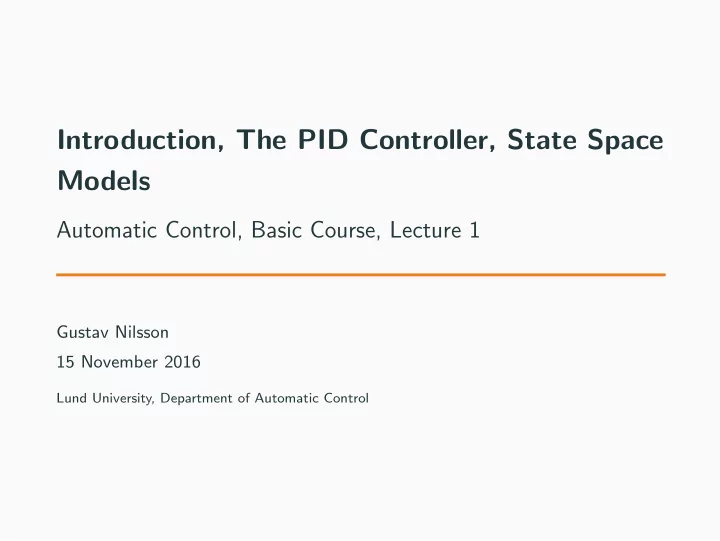

Introduction, The PID Controller, State Space Models Automatic Control, Basic Course, Lecture 1 Gustav Nilsson 15 November 2016 Lund University, Department of Automatic Control
Content 1. Introduction 2. The PID Controller 3. State Space Models 2
Introduction
The Simple Feedback Loop y r u Controller Process • Reference value r • Control signal u • Measured signal/output y The problem: Design a controller such that the output follows the reference signal as good as possible 4
Find the Control Problem - 1 5
Find the Control Problem - 1 • Reference value - Desired temperature • Control signal - E.g., power to the AC, amount of hot water to the radiators • Measured value - The temperature in the room 5
Find the Control Problem - 2 6
Find the Control Problem - 2 • Reference value - Desired speed • Control signal - Amount of gasoline to the engine • Measured value - The speed of the car 6
Find the Control Problem - 3 7
Find the Control Problem - 3 • Reference value - Number of bacterias • Control signal - Food • Measured value - E.g., the oxygen level in the tank 7
Feedforward Some systems can operate well without feedback, i.e., in open loop. Disturbances y r u Controller Process Examples of open loop systems? 8
Feedforward vs. Feedback Benefits with feedback: • Stabilize unstable systems • The speed of the system can be increased • Less accurate model of the process is needed • Disturbances can be compensated • WARNING: Stable systems might become unstable with feedback Feedforward and feedback are complementary approaches, and a good controller typically uses both. 9
The PID Controller
The Error The input to the controller will be the error, i.e., the difference between the reference value and the measured value. e = r − y y r u Controller Process New block scheme: y r e u + Controller Process − 1 11
On/Off Controller � u max if e > 0 u = if e < 0 u min u u max u min e Usually not a good controller. Why? 12
The P Part Idea: Decrease the controller gain for small control errors. P-controller: u max if e > e 0 u = u 0 + Ke if − e 0 ≤ e ≤ e 0 u min if e < − e 0 u u max u 0 u min e e 0 − e 0 13
The P Part Idea: Decrease the controller gain for small control errors. P-controller: u max if e > e 0 u = u 0 + Ke if − e 0 ≤ e ≤ e 0 u min if e < − e 0 The control error e = u − u 0 K To have e = 0 at stationarity, either: • u 0 = u • K = ∞ 13
The P Part Idea: Decrease the controller gain for small control errors. P-controller: u max if e > e 0 u = u 0 + Ke if − e 0 ≤ e ≤ e 0 u min if e < − e 0 The control error e = u − u 0 K To have e = 0 at stationarity, either: • u 0 = u (What if u varies?) • K = ∞ (On/off control) 13
The I Part Idea: Adjust u 0 automatically to become u . PI-controller: � 1 � � u = K e ( t ) d t + e T i Compared to the P-controller, now u 0 = K � e ( t ) d t T i At stationary e = 0 if and only if r = y . PI controller archives what we want, if performance requirements are not extensive. 14
The D Part Idea: Speed up the PI-controller. PID-controller: � e + 1 � d e � u = K e ( t ) d t + T d T i d t e e I I P P Time Time t t P acts on the current error, I acts on the past error, D acts on the ”future” error 15
State Space Models
State Space Models y u Process Linear dynamics can be described in the following form x = Ax + Bu ˙ y = Cx (+ Du ) Here x ∈ R n is a vector with states. States can have a physical ”interpretation”, but not necessary. In this course u ∈ R and y ∈ R will be scalars. (For MIMO systems, see Multivariable Control (FRTN10)) 17
Example Example The position of a mass m controlled by a force u is described by m ¨ x = u where x is the position of the mass. u m Introduce the states x 1 = ˙ x and x 2 = x and write the system on state space form. Let the position be the output. 18
Dynamical Systems Continous Time Discrete Time (sampled) Linear This course Real-Time Systems (FRTN01) Nonlinear Nonlinear Control and Servo Systems (FRTN05) Next lecture: Nonlinear dynamics can be linearized. 19
Recommend
More recommend